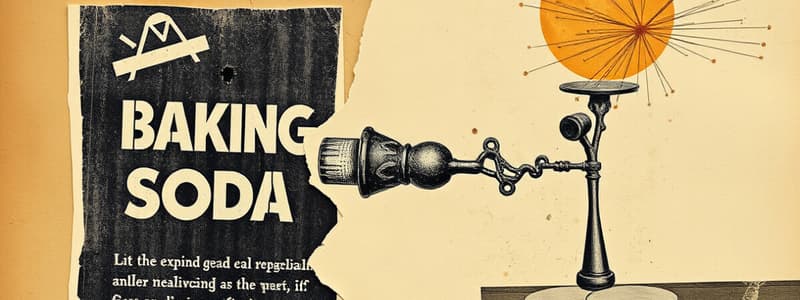Podcast
Questions and Answers
What is the chemical formula of baking soda?
What is the chemical formula of baking soda?
NaHCO₃
Who is credited with the discovery of sodium bicarbonate?
Who is credited with the discovery of sodium bicarbonate?
- Austin Church
- John Dwight
- Robert Hooke
- Valentin Rose the Younger (correct)
Baking soda only occurs naturally as Nahcolite.
Baking soda only occurs naturally as Nahcolite.
False (B)
Which of the following is NOT a use of baking soda?
Which of the following is NOT a use of baking soda?
What is the melting point of baking soda?
What is the melting point of baking soda?
Baking soda can help soothe tired feet and soften _______.
Baking soda can help soothe tired feet and soften _______.
Which process is primarily used to produce baking soda?
Which process is primarily used to produce baking soda?
What is the pH of a solution of baking soda?
What is the pH of a solution of baking soda?
Which of the following is a reaction of baking soda with hydrochloric acid?
Which of the following is a reaction of baking soda with hydrochloric acid?
What is one health use of baking soda?
What is one health use of baking soda?
Flashcards are hidden until you start studying
Study Notes
Baking Soda Overview
- Sodium bicarbonate (NaHCO₃), also known as baking soda, is a white crystalline compound that often appears as a fine powder.
- It consists of a sodium cation and a bicarbonate anion.
History
- Discovered by pharmacist Valentin Rose the Younger in 1801 in Berlin.
- In 1846, American bakers John Dwight and Austin Church established the first US factory for its production from sodium carbonate and carbon dioxide.
Other Names
- Commonly referred to as baking soda, bicarbonate of soda, or nahcolite.
Taste and Physical Properties
- Exhibits a slightly salty, alkaline taste similar to sodium carbonate.
- White color, crystalline structure, powdery at room temperature, odorless, and non-flammable with a melting point of 50°C.
Reactions
- Reacts with hydrochloric acid to produce sodium chloride, carbon dioxide, and water.
- Combines with acetic acid to generate carbon dioxide and sodium acetate.
- Interacts with citric acid resulting in carbon dioxide and sodium citrate.
- Reacts with calcium chloride to form calcium carbonate and sodium chloride.
Health and Medical Uses
- Acts as an antacid, freshening breath, and maintaining oral hygiene.
- Used as a gentle exfoliant for skin.
- A baking soda foot soak can soothe tired feet and deodorize.
- Drinking a mixture can help relieve symptoms of urinary tract infections (UTIs).
- Applied as a paste, it may combat nail fungal infections.
General Uses
- Utilized in cosmetics and personal care products.
- Functions as a water softener and is effective for cleaning.
- Essential in making baking powder and used in fire extinguishers.
Production Process
- Primarily produced through the Solvay process which involves the preparation of brine, ammonia absorption, carbonation, filtration, and drying to yield pure baking soda.
Scientific Significance
- Used as a standard in acid-base titrations.
- Can prepare buffer solutions and generate carbon dioxide in lab experiments.
- Demonstrates concepts of chemical reactions and neutralization in educational settings.
Environmental Uses
- Neutralizes acidic soils and helps reduce water acidity.
- Functions as a cleaning agent for surfaces and air deodorizing.
- Useful in pest control and managing oil spills.
Natural Occurrence
- Found naturally as a mineral called nahcolite, formed in areas with sodium carbonate deposits.
- Occurrences include Green River Formation (USA), Searles Lake (California), and Lake Magadi (Kenya).
Chemical Properties
- Basic in nature with a pH of 8.3 in solution.
- Partially soluble in water with a melting point of 500°C and boiling point of 851°C.
- Molecular weight is 84.0066 g/mol, acts as a buffer to maintain stable pH levels.
Studying That Suits You
Use AI to generate personalized quizzes and flashcards to suit your learning preferences.



